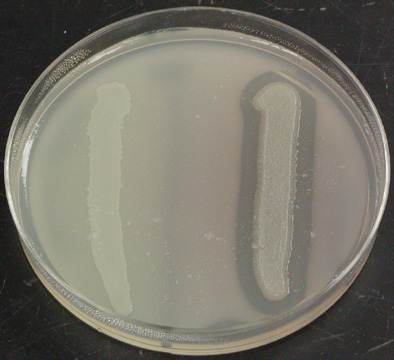Lipase Test
In our lab, the only lipase test we perform is the tributyrin agar test.
Tributyrin agar is a differential medium that tests the ability of an organism to produce an exoenzyme, called lipase, that hydrolyzes tributyrin oil. Lipases break down lipids (fats). Tributyrin oil is a type of lipid called a triglyceride. Other lipase tests use different fat sources such as corn oil, olive oil, peanut oil, egg yolk, and soybean oil.
Lipase allows the organisms that produce it to break down lipids into smaller fragments. Triglycerides are composed of glycerol and three fatty acids. These get broken apart and may be converted into a variety of end-products that can be used by the cell in energy production or other processes.
Tributyrin oil forms an opaque suspension in the agar. When an organism produces lipase and breaks down the tributyrin, a clear halo surrounds the areas where the lipase-producing organism has grown.
 |
The Salmonella typhimurium on the left is negative for
lipase production. |
The Pseudomonas aeruginosa on the right is positive for
lipase production, as evidenced by the clearing surrounding the growth. |
